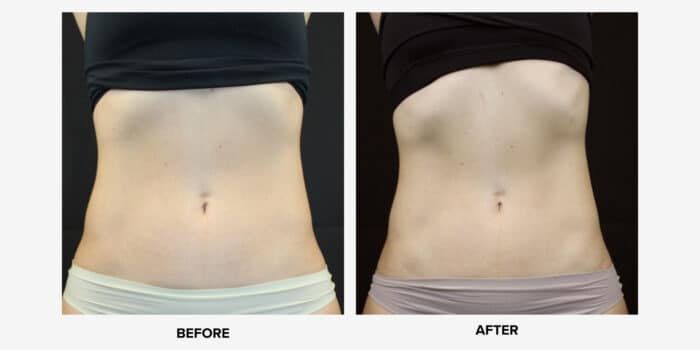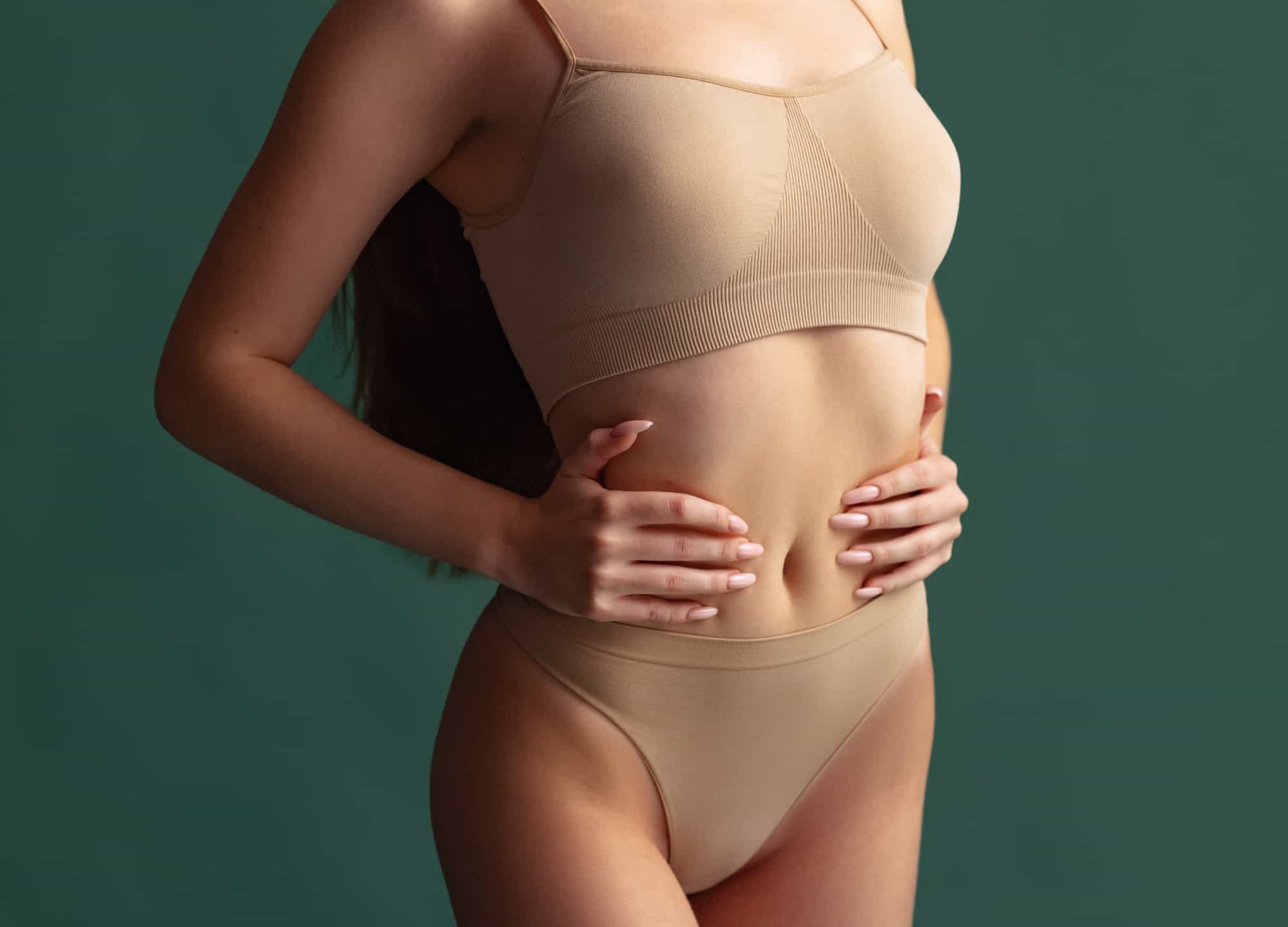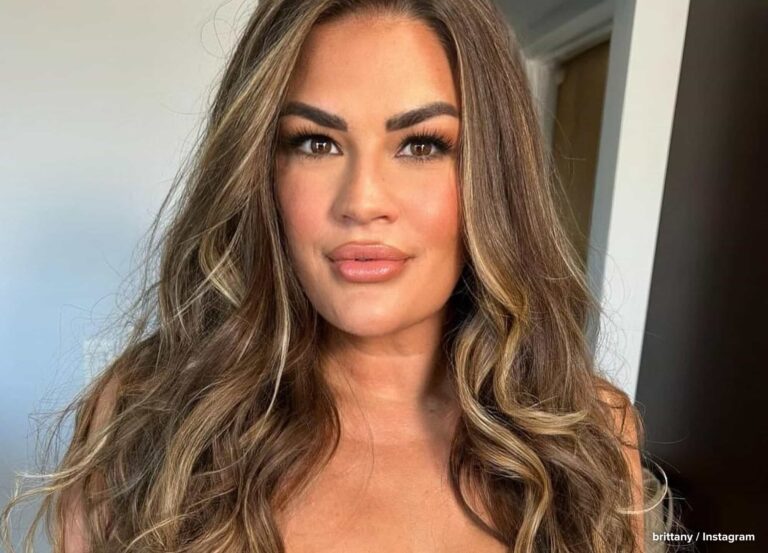The treatment
TruBody, a pairing of two different treatments—truSculpt for fat reduction and truFlex for muscle toning. I did one session of truSculpt and a series of six truFlex treatments on my abdominals and obliques.
The provider
Dr. Ashish Bhatia, a board-certified dermatologist in Itasca, Illinois
What is truBody?
TruBody is the combination of truSculpt and truFlex. TruSculpt is a noninvasive treatment that uses radiofrequency technology to heat up and subsequently kill fat cells. “It’s also the only fat-reduction treatment that’s been shown to help tighten the skin because of the way it heats the derms,” Dr. Bhatia explains. It uses targeted paddles that can be applied pretty much anywhere on the body and works in just 15 minutes. Most people are candidates, even those with higher BMIs, although those patients may require more treatments, he explains.
“TruFlex is a system that uses an electrical current to stimulate muscles, toning and conditioning them,” says Dr. Bhatia. The device features 16 paddles, which can be applied on areas such as the abs, thighs, obliques, quads, calves, flanks, buttocks; this also allows you to target multiple areas of the body simultaneously.
TruBody vs. EmSculpt Neo
Emsculpt Neo combines fat melting and muscle toning in one device, whereas truBody requires separate treatments with two different devices. Emsculpt uses electromagnetic energy for muscle stimulation, whereas truFlex uses an electric current, says Dr. Bhatia. That electromagnetic energy also targets a very wide area—it features one or two large paddles, and any muscle that’s in the path of those paddles gets blasted with the energy, he adds. TruFlex is much more targeted, allowing you to treat very specific muscles as well as customize the level of intensity for each muscle area, he explains.
Why I tried it
I’ve always been very physically active and prioritized diet and exercise—for aesthetic reasons but also because I really do like feeling strong. I got pregnant with twins last year and worked out throughout my entire pregnancy, then started back up postpartum as soon as I got the okay from my doctor. Having two babies changed my body (obviously), but I did recover fairly easily, all things considered. I regained my core strength fairly quickly, and I felt pretty much back to normal at about the six-month mark (after feeling like a stranger in my own skin until then).
But I was still hanging onto the last few pounds of stubborn baby weight and felt like the shape and look of my stomach and abs—which had never been a trouble spot for me—just looked different. I went in for my truBody consult when I was eight months postpartum, hoping that this would be the little added boost I needed to finally take me across the finish line so that I would totally feel like my old self. I was well aware that these types of treatments are by no means a substitute for diet and exercise, nor did I want them to be. Rather, I looked at them as the icing on the cake to all of the hard work I was putting in.
Dr. Bhatia and I first talked about truSculpt. He noted that I actually didn’t have that much excess fat on my stomach (bless his heart), which is part of the reason we opted to do just one treatment; standard protocol is two treatments, three months apart. I was down for some fat melting—who wouldn’t be?—but even more so loved the idea of some simultaneous skin tightening. The skin on my stomach wasn’t very loose, but it definitely was more lax than I liked, especially when I bent over.
We then chatted about truFlex. While he pointed out that anyone can benefit, he noted that I was a good candidate because I was fairly lean and already had good muscle tone, which meant I’d likely see impressive results. The biggest downside would be the time commitment: truFlex calls for two sessions per week for three weeks. And while I’d be hooked up to the machine for only 45 minutes, the added time spent getting hooked up to the paddles and having them removed (not to mention drive time to and from the office) meant this would be close to a two-hour situation every time. I didn’t love that, as a working mom with young babies, but decided it would, hopefully, be worth it.
What truBody treatment was like
At the risk of sounding flippant, truSculpt was, honestly, a piece of cake. I was warned that it would feel really hot, akin to a hot-stone massage on steroids. I have a pretty high pain tolerance and also generally like heat (I’m one of those people who would always rather be hot than cold), so I wasn’t all that concerned. Dr. Bhatia marked up my lower stomach, flanks and obliques, and the paddles were applied. I lay on my back, and the treatment, which is only 15 minutes, started. It gradually got hotter and hotter, and while it certainly wasn’t enjoyable, it was never that unpleasant and definitely not painful. I lay back and scrolled on my phone, and it was over before I knew it. My stomach was red, in the areas where the paddles had been placed, for about 24 hours—a normal side effect—but I had no other issues after, nor were there any restrictions in terms of physical activity.
TruFlex was a different ball game. The paddles were attached in a particular pattern along my abs and obliques meant to maximize definition and tone. The electrical current made for a burning, zapping sensation that was coupled with pretty intense muscle contractions—so intense that I could often see my muscles moving and pulsating. The device works by using different types of contraction and stimulation patterns, each of which lasts for a few minutes. After each of these, the stimulation would stop (a brief respite for a few seconds) before the next sequence kicked in. The nurse practitioner (NP) who administered the treatment would tell me what level I was at (these range from 0 to 100) and ask me every few minutes if I wanted to increase the intensity. I’m extremely competitive, so my answer was always yes. At each subsequent treatment, I’d then want to beat my numbers from before.
Worth noting: I tried the treatment both lying on my stomach and on my back. When I lay on my stomach, I could actually tolerate higher levels; my hypothesis is that the added pressure helped. I was also able to dial up the intensity more on my obliques than on my abs. (Again, it’s the way the paddles on this machine are customized that allows for this type of variation.)
My other big takeaway: your provider matters. I had the same NP for my first four sessions, and she’d bump up my numbers occasionally but also dip in and out of the room for a few minutes at a time, leaving me to my own devices when it came to increasing the intensity. I would, due to my competitive nature, but I could also see how a lot of people would take advantage of that and not raise their numbers.
However, treatments five and six were administered by a different NP. I loved her, but she probably would be better suited as a West Point boot camp instructor. She immediately told me my numbers should be way higher (I had been hovering in the 60s). Her protocol was to increase the intensity by a point or two every 90 seconds. Needless to say, those last two sessions featured lots of deep breathing and a few choice expletives rather than mindless phone scrolling. That being said, I actually appreciated this approach.
I was warned that I might be sore after truFlex, but that never happened. I experienced phantom tingles after the paddles came off, feeling like they were still attached and I was still getting zapped, kind of like when you come out of the ocean and feel like you’re still bobbing in the waves. But that went away after a few minutes, and even after those last two hardcore sessions, I was never sore.
My results

My after photo was taken after the six sessions, which I ended up doing over the course of a month rather than three weeks (blame scheduling issues). To be candid, I also lost about two pounds during this time. Full results of the truFlex treatments are seen after the series of six, although Dr. Bhatia told me that many people see some effects even sooner. I did notice, when trying on clothes after the first two sessions, that my waist looked smaller and tighter. Was that truFlex or my continued focus on diet and exercise? Unclear, but I did notice something. After completing the full protocol, I feel like the definition in my abs is even closer to what it was before I had babies. Even more notably, it strengthened my core. My abs feel stronger during all my workouts, which in turn actually allows me to work even harder. Dr. Bhatia adds that, aesthetics aside, this is a common reason many of his patients opt for truFlex. “We use it on everyone, from high-performance athletes who want to take their performance to the next level to elderly patients who suffer from back pain and need core strengthening but can’t do crunches,” he says.
After the initial six sessions, it’s recommended to move to a maintenance phase four weeks later, which involves one 15-minute truFlex treatment, every three to four weeks. The thinking is that, like working out in the gym, you need to keep it up in order to maintain results. As far as truSculpt fat melting and skin-tightening results go, Dr. Bhatia said those would take about three months to see. I’m currently five weeks post-treatment, so how well that worked remains to be seen. I haven’t noticed any changes yet.
Final verdict
I found truSculpt to be an incredibly easy, quick, painless treatment. If it does, in fact, yield the fat reduction and skin tightening it claims, I’d say it’s absolutely worth it. As far as truFlex goes, it’s intense. The ability to target multiple areas at the same time is a major benefit, although I’d advise trying to stick with the same provider for every session, as I do think this impacts the overall experience and end result. All that being said, I’m liking both the aesthetic and functional results and will consider moving into the maintenance phase, especially given that it requires only a 15-minute commitment monthly.











